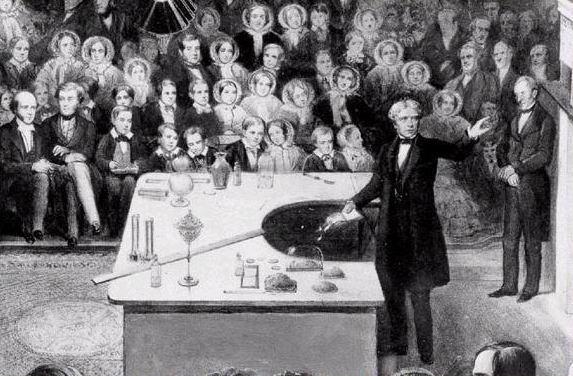SAT写作素材之迈克尔·法拉第Michael Faraday
- 2015年03月11日16:11 来源:小站整理
- 参与(0) 阅读(6784)
法拉第是英国物理学家、化学家,也是著名的自学成才的科学家。1791年9月22日,法拉第出生在萨里郡纽因顿一个贫苦铁匠家庭。
因家庭贫困仅上过几年小学,13岁时便在一家书店里当学徒。书店的工作使他有机会读到许多科学书籍。在送报、装订等工作之余,自学化学和电学,并动手做简单的实验,验证书上的内容。利用业余时间参加市哲学学会的学习活动,听自然哲学讲演,因而受到了自然科学的基础教育。
由于他爱好科学研究,专心致志,受到英国化学家戴维的赏识,1813年3月由戴维举荐到皇家研究所任实验室助手。这是法拉第一生的转折点,从此他踏上了献身科学研究的道路。
同年10月戴维到欧洲大陆作科学考察,讲学,法拉第作为他的秘书、助手随同前往。历时一年半,先后经过法国、瑞士、意大利、德国、比利时、荷兰等国,结识了安培、盖.吕萨克等著名学者。沿途法拉第协助戴维做了许多化学实验,这大大丰富了他的科学知识,增长了实验才干,为他后来开展独立的科学研究奠定了基础。 法拉第主要从事电学、磁学、磁光学、电化学方面的研究,他关于磁生电的跨时代的伟大发现,使人类掌握了电磁运动相互转变以及机械能和电能相互转变的方法,成为现代发电机、电动机、变压器技术的基础。
法拉第能够这样坚持10年矢志不渝地探索电磁感应现象,重要原因之一是同他关于各种自然力的统一和转化的思想密切相关的,他始终坚信自然界各种不同现象之间有着无限多的联系。也是在这一思想的指导下,他继续研究当时已知的伏打电池的电、摩擦电、温差电、伽伐尼电、电磁感应电等各种电的同一性,1832年他发表了《不同来源的电的同一性》论文,用大量实验论证了“不管电的来源如何,它的本性都相同”的结论,从而扫除了人们在电的本性问题认识上的种种迷雾。
Faraday, Michael (1791-1867)
Physicist and chemist. Born September 22, 1791, in Newington, Surrey. The family soon moved to London, where young Michael, one of 10 children, picked up the rudiments of reading, writing, and arithmetic. At the age of 14, he was apprenticed to a bookbinder and bookseller. He read ravenously and attended public lectures, including some by Sir Humphry Davy. Faraday's career began when Davy, temporarily blinded in a laboratory accident, appointed Faraday as his assistant at the Royal Institution. With Davy as a teacher in analytical chemistry, Faraday advanced in his scientific apprenticeship and began independent chemical studies. By 1825, he discovered benzene and had become the first to describe compounds of chlorine and carbon. He adopted the atomic theory to explain that chemical qualities were the result of attraction and repulsion between united atoms. This proved to be the theoretical foundation for much of his future work.
Faraday had already done some work in magnetism and electricity, and it was in this field that he made his most outstanding contributions. His first triumph came when he found a solution to the problem of producing continuous rotation by use of electric current, thus making electric motors possible. Hans Oersted had discovered the magnetic effect of a current, but Faraday grasped the fact that a conductor at rest and a steady magnetic field do not interact and that to get an induced current either the conductor or the field has to move. On August 29, 1831, Faraday discovered electromagnetic induction.
During the next 10 years, Faraday explored and expanded the field of electricity. In 1834, he announced his famous two laws of electrolysis. Briefly, they state that for any given amount of electrical force in an electrochemical cell, chemical substances are released at the electrodes in the ratio of their chemical equivalents. He also invented the voltammeter, a device for measuring electrical charges, which was the first step toward the later standardization of electrical quantities. Faraday continued to work in his laboratory, but his health began to deteriorate and he had to stop work entirely in 1841. Almost miraculously, however, his health later improved and he resumed work in 1844. He began a search for an interaction between magnetism and light and in 1845 turned his attention from electrostatics to electromagnetism. He discovered that an intense magnetic field could rotate the plane of polarized light, a phenomenon known today as the Faraday effect. In conjunction with these experiments, he showed that all matter conducts the magnetic line of force. Objects that were good conductors he called paramagnetics, while those that conducted the force poorly he named diamagnetics. Thus, the energy of a magnet is in the space around it, not in the magnet itself. This is the fundamental idea of the field theory.
Faraday was a brilliant lecturer, and through his public lectures he did a great deal to popularize science. Shortly after he became head of the Royal Institution in 1825, he inaugurated the custom of giving a series of lectures for young people during the Christmas season. This tradition has been maintained, and over the years the series have frequently been the basis for fascinating, simply written, and informative books. Faraday died in London on August 25, 1867. The admiration of physicists for Faraday has been demonstrated by naming the unit of capacitance the farad and a unit of charge, the faraday. No other man has been doubly honored in this way. His name also appears frequently in connection with effects, laws, and apparatus. These honors are proper tribute to the man who was possibly the greatest experimentalist who ever lived.


























